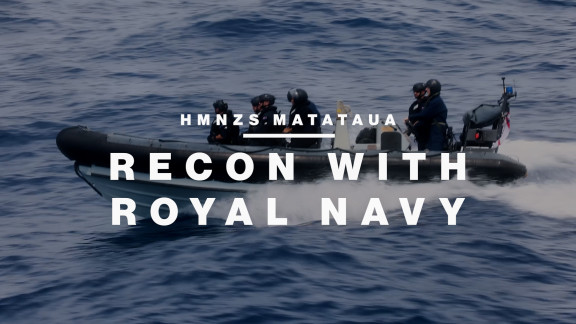Collaborative work at Australian airshow
08 April 2025
Unfortunately you are viewing this website on an outdated browser which does not support the necessary features for us to provide an adequate experience. Please switch to a modern browser such as latest version of Google Chrome, Mozilla Firefox, Apple Safari or Microsoft Edge.
Ngā mihi nui
Uncrewed Aerial System (UAS) teams from HMNZS Matataua can be dispatched for an ‘on call’ surveillance work with other nations.
Petty Officer Physical Training Instructor Marc Thomas and Able Seamanship Combat Specialist Joel Jackson joined the crew of Royal Navy patrol ship HMS Tamar in early August for Operation Island Chief, involving fisheries patrols in the south-west Pacific.
Their job, using drones launched from the flight deck, was to provide an Information Surveillance and Reconnaissance (ISR) capability of fishing vessels in the area.
There was no boarding of vessels, says POPTI Thomas.
“We’d put the drone up and fly it over a Fishing Vessel of Interest (FVOI),” he says. “Later, we would download the data and the ship sends off a report. It’s purely surveillance, establishing a picture of what boats are out here.”
Within 20 minutes of a vessel being located, the UAS would be in the air.
The ship was augmented during the week by surveillance reports from a United States Coast Guard C130 Hercules and an RNZAF P-8 Poseidon aircraft, helping build a bigger picture.
“A deployable UAS team is very cost-effective and we can deploy at short notice with minimal crew,” he says. “This was our first international UAS deployment following our course.”
The capability was recognized during a previous six-week deployment in Tamar with Matataua’s Deployable Boarding Team in April (Navy Today May 2024) in Fijian waters. One of the team trialed a drone during boarding operations.
“The guy did such a good job back then, we got a request for UAS support for Tamar. They were pretty keen to work with us. There’s lot of people in Matataua qualified now. We can put our people on a ship and achieve the mission, and it’s very positive interoperability.”
He says Tamar’s crew was very hospitable and made them feel like they were part of the crew, rather than sea riders.
“This operation has continued to strengthen our relationship with the Royal Navy, spreading our Navy’s reputation as competent, hardworking and synergetic.”
The mission adds to a growing list of RNZN interactions with Tamar, which is forward-deployed to the Indo-Pacific region for five years. Crews are rotated in while the ship remains in the region.

Teaming with HMS Tamar | Royal New Zealand Navy
As well as the Fiji and UAS missions, Matataua has supplied Tamar with a Deployable Survey Team to assist Royal Navy hydrographers with charting waters near Nauru.
The ship has also embarked Royal New Zealand Navy warfare officers for Officer of the Watch training, including Midshipman Kalani Doole while the UAS pair were on board.
Commander Trevor Leslie, Commanding Officer Matataua, says the success of Island Chief “not only reinforces the success of the Deployable Boarding Team concept but also the value of Matataua’s ‘constellation of capabilities’ being scalable, exportable and value for money in this contemporary operating environment.
“The unit’s culture of innovation has seen a number of Junior Officers and sailors cross-trained in boarding and UAS operations which enhances their utility and usefulness. It’s not only mission success, but fiscal savings and a retention positive environment.”